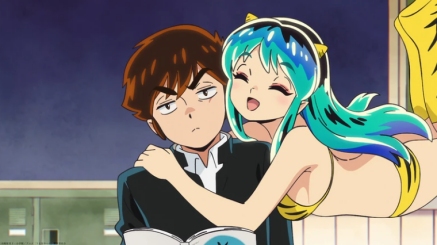

"Rumiko Takahashi Encouraged Them to Make Bold Changes."
What is the Commitment to the Reiwa Urusei Yatsura?
Translation By: Dylan Acres
Rumiko Takahashi encouraged the staff to make bold changes. What is the commitment of the 2022 version of the anime Urusei Yatsura?
The TV anime Urusei Yatsura began broadcasting on Fuji Television's late-night anime broadcast slot "Noitamina" on October 13, 2022 (Thursday). What was the reason for the decision to adapt the anime again in 2022, and why did they take on the challenge of a four-cour broadcast period?
Back for the anniversary year!
Manga artist Rumiko Takahashi's debut work Urusei Yatsura, the first anime series of which ran for about five years from 1981, was one of the most influential works in manga and anime culture in the late Showa period. Why is Urusei Yatsura being animated again in the Reiwa era?We interviewed Noriko Ozaki (Fuji TV), who was involved in the launch of the anime adaptation of the TV animation Urusei Yatsura, Kento Moriwaki (Shogakukan), the editor in charge of the Urusei Yatsura anime at the time of its creation, and current editor Riri Okamoto (Shogakukan), who was involved in the production behind the scenes.

Please tell us how the decision to make a completely new anime adaptation of Urusei Yatsura was made.
Noriko Ozaki: The timing coincided with a milestone, it came about due to the timing of Shogakukan's 100th anniversary. In early spring of 2019, I was approached by Fuji Television's Anime Production Department, "we have a chance to make an anime adaptation of Urusei Yatsura, what would you like to do?"What did Mr. Moriwaki, the editor in charge at the time the anime adaptation was decided, think when he heard about it?
Kento Moriwaki: There are many people, regardless of their generation, who know Lum-chan. On the other hand, I was bothered by the fact that there were many people who did not know how interesting Urusei Yatsura itself was. That's why I was so happy to see such an interesting work being made into an anime again! I was so happy. [1]How did Takahashi-sensei react?
Moriwaki: She didn't seem overly excited, but rather quietly happy. Perhaps it was because she has had so many of her works adapted for film, but I thought she was like Ichiro, who maintains his composure whether he hits a home run or strikes out. I thought, "exceptional people are unique" (laughs).Riri Okamoto: I took over from Moriwaki as her editor while the production of the anime was in progress, and every time Takahashi-sensei would exclaim, "This is wonderful!" She was delighted with the staff and cast members and the theme song has a great tempo. It's the best. [2]
I know Lum-chan, but Urusei Yatsura Can be Interesting for Those Who Aren't Familiar It.

I think it was also necessary to express the works of the Showa era according to the present age. Have you ever been conscious of that?
Moriwaki: Takahashi-sensei seemed to have a strong feeling that "If you make it into an anime, I want young people to see it." In a good way, it's okay to make it a Showa style based on the original, and it's also okay to change the scenes that don't follow the current broadcasting ethics. [3]Ozaki: I am very grateful that she said that. In creating the scenario, we thought we should revise expressions that would not be funny to today's viewers. It has been about 35 years since the first series was broadcast, and I thought that what could have been treated as a joke in the past might not be in line with today's social norms, or might be perceived as cold by foreign, overseas viewers.
However, it would be a waste to change a characters personality and lose their individuality. Therefore, I was conscious throughout all the episodes to make the story enjoyable for all viewers by changing the background without changing the main focus, or making minor changes that would not be noticed if viewed in a streamlined manner.
Moriwaki: You really have paid a lot of attention to each character. In particular, with Lum-chan, Takahashi-sensei was pleased that we took the "cute and elegant" design that she had maintained since the beginning of the series and added a cute, pop, modern touch to it.
Using Advertising Techniques to Create a Different, Special Atmosphere
The four-cour broadcast period, is unusual for a recent TV animation series, what made you decide to announce that?
Ozaki: If we were going to do an anniversary project, we wanted to do it all at once. But it would take years to animate all of the stories, so we decided to make a 4-cour best-of series because it has the advantage of not being animated concurrently during the (manga) series' run. [4]
Instead of announcing all four cours at once (2 cour will be broadcast from October 2022 to March 2023), you chould have announced the third and fourth cour after the ending of the second cour. What was the intention of announcing all four at the outset?
Ozaki: "The anniversary festival will not last forever. That's why we're going to make this fun and energetic! Please stand by for more information!" This can be said for the fact that we announced the decision to make an anime on New Year's Day because it was the "Year of the Tiger" and that we uploaded a teaser video with all the subtitles to be broadcast in the first season in advance, but in any case, we wanted to do something out of the ordinary.The full-page advertisement published in the Sankei Shimbun on January 1, 2022 became a big topic.
Ozaki: While we had the option of lifting the ban and announcing in Weekly Shonen Sunday, where Takahashi-sensei's new work MAO is currently being serialized, we were grateful that Shogakukan agreed to let us announce there.Moriwaki: Lately, leaked information has been uploaded to the internet when the magazine gets sent to the printers for production and distribution, so we try not to advertise too much in the magazine. But, we had no problem at all in releasing the information in the newspaper.
Ozaki: As well as the release of information in the newspaper, we also received a great response to the linked visuals of character illustrations and cast photos drawn by Naoyuki Asano (who is in charge of character design). The response was so strong that we added linked visuals of other characters, including Shinobu and Mendo, to the website.
On the other hand, why did you release the casting of Toshio Furukawa, who played Ataru in the first anime series (this time playing Ataru's Father), and Fumi Hirano, who played Lum (this time playing Lum's Mother), just before the start of the anime broadcast?
Ozaki: When we announced the decision to make an anime, we announced the casting of Ataru and Lum on the same day as the announcement of the anime, rather than having various people try predict who would be cast. That is how confident the production team felt that we could introduce these two new cast members. In fact, at this time, we also had Mr. Furukawa and Ms. Hirano agree to join the cast, but we decided to announce them at a later date as a pleasant surprise after the main new cast members had all come out.Keiko Toda (who plays Ataru's Mother), who does not often accept new work in animation, accepted Director (Hideya) Takahashi's offer, saying "Well, if it's Urusei Yatsura..." so we decided to announce the four cast members of Ataru and Lum's parents all at once, who are just fantastic.

Finally, what are some of the points you would like people to pay attention to?
Moriwaki: The characters are very attractive. Especially Ataru, who is very cool. In the original story, he's a dirty, frivolous, tough and funny guy, but if you watch the anime, I think it's been rebooted in such a way that you can rediscover how cool he is as well. Kamiya-san's voice is also exquisite and ...I was moved. As a side note, I heard that the character of Takahashi-sensei's who received the most Valentine's Day chocolates is not Inuyasha or Sesshomaru, but Ataru.All: Surprising! (laugh)
Okamoto: Come to think of it, he's somehow popular even in the series itself (laughs). Incidentally, Takahashi-sensei also said that "Ataru in the anime is very handsome," so he may have a different charm than in the original work.
Ozaki: The directors had a hard time deciding how far to go in expressing Ataru without being negative. But the fact that he had to work so hard was proof that he was the star of the show. Ms. Takahashi also said, "He's the main character, so he should suffer a lot of hardships."
Okamoto: Not only is Ataru cool, but I thought that Lum-chan moving around was the cutest. The scene where she is spinning around makes me want to rewind and watch it over and over again (laughs). The color gradation of her hair is also unique in the anime.
Ozaki: The hair color of Lum-chan in the original work was not painted in one fixed color, so it took a lot of trial and error to see how it could be expressed in the new animated version, and I think the director and staff will be very pleased with your comments, Okamoto-san.
Moriwaki: There are so many aspects of the characters that can be rediscovered by watching the new animation, so I hope that you will pay attention to them.
Okamoto: After seeing this work, I was again impressed by the fact that the fun of Urusei Yatsura is still relevant in this day and age. I think it's the strength and the universal theme of romantic comedy, but Urusei Yatsura depicts relationships that are different from those in today's romantic comedies. I hope that this work will be a chance for newcomers to look back on the relationship between Ataru and Lum, and to discover a new form of romantic comedy that has come full circle.
Yuka Abe is an interview writer who loves anime, music, movies, manga, and commercial BL. After working as a web media director and editor, she is active in the entertainment and business fields as a freelance writer. She is the co-author of BL Juku Boys' Love, Do you want to know more?.
Footnotes
- [1] Kento Moriwaki was Takahashi's editor from 2016 during Kyokai no RINNE through chapter 108 of MAO. He oversaw her debut on Twitter as well, and discusses that in this interview.
- [2] Riri Okamoto is Rumiko Takahashi's first female editor and took over after Kento Moriwaki was moved to Hoankan Evans no Uso: Dead or Love (保安官エヴァンスの嘘~DEAD OR LOVE~). Okamoto was announced as Takahashi's new editor in the Wednesday Diary, a bonus page illustrated by a different artist each week in Shonen Sunday.
- [3] The Showa Era existed from December 25, 1926 – January 7, 1989.
- [4] The Japanese have sometimes subdivided television series and dramas into kūru (クール), from the French term "cours" (both singular and plural) for "course", which is a 3-month period usually of 13 episodes. Each kūru generally has its own opening and ending image sequence and song, recordings of which are often sold. A six-month period of 26 episodes is also used for subdivision in some television series. "Television in Japan,” Wikimedia Foundation, last modified November 8, 2022, 14:50, https://en.wikipedia.org/wiki/Television_in_Japan#Programs

Otokoto
|